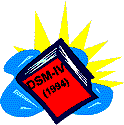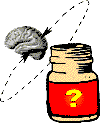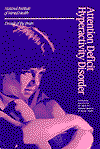 | ADHD Gets Some Attention (Attention Deficit Hyperactivity Disorder) |  |
 | ADHD Gets Some Attention (Attention Deficit Hyperactivity Disorder) |  |
|
Attention Disorder Hyperactivity Disorder
(ADHD) affects between 1.5 and 3.5 million school-age children in
the U.S., or an estimated 5% of all boys and 2% of all girls. Why ADHD
affects more boys than girls is a mystery at this point. Up to 60% of
these children will continue to have symptoms into adulthood. According
to the National Institutes of Health, more than a million children take
prescription medicines to control hyperactive behavior. The estimated
cost to schools is about 3 billion dollars.
|
Contents of this Page
|
Signs to Look For Almost all
people at some point exhibit some of the symptoms of ADHD. We all get
distracted at times; we all have had trouble finishing work or tasks.
However, children with ADHD are, in general, less able
to care for themselves, less able to recognize appropriate social
behavior, and less able to communicate than children without ADHD of the
same age. The Diagnostic and Statistical Manual of Mental Disorders
(DSM-IV) published by the American Psychiatric Association has a very
specific listing of behaviors that must be observed before a diagnosis of
ADHD is made. Almost all
people at some point exhibit some of the symptoms of ADHD. We all get
distracted at times; we all have had trouble finishing work or tasks.
However, children with ADHD are, in general, less able
to care for themselves, less able to recognize appropriate social
behavior, and less able to communicate than children without ADHD of the
same age. The Diagnostic and Statistical Manual of Mental Disorders
(DSM-IV) published by the American Psychiatric Association has a very
specific listing of behaviors that must be observed before a diagnosis of
ADHD is made.There are many reasons other than ADHD why children may have these behaviors. Infections, learning disabilities, or educational issues may result in symptoms similar to ADHD.
| ||||||
Examining the CauseThe cause of ADHD is not clear-cut. It appears that certain receptors in the brain which normally respond to the neurotransmitter called dopamine are not working properly. Most likely, dopamine is not being produced at normal levels in the brain. Recent work in adults points to a defect in an enzyme called dopa decarboxylase which helps make dopamine. This defect in dopamine production occurs in the anterior frontal cortex, an area associated with cognitive processes such as focusing and attention.Evidence shows that children who were born weighing less than 1500 grams (3.3 pounds) or who had birth complications may be more prone to ADHD. Additionally, studies have linked resistance to thyroid hormones to hyperactivity and lack of impulse control, but it is unclear how this impacts ADHD.
According to the National Institutes on Health, ADHD is not usually caused by:
Adoption studies provide more evidence of a genetic link to ADHD: biological relatives of children with ADHD have a higher chance of having ADHD than adoptive relatives of children with ADHD. |
Structural SignsStudies in the past few years have shown that boys with ADHD tend to have brains that are more symmetrical in shape. Three structures in the ADHD boys' brains were smaller than in non-ADHD boys of the same age: prefrontal cortex, caudate nucleus, and the globus pallidus. The prefrontal cortex is thought to be the brain's "command center;" the other two parts translate the commands into action.
Although the brain scan, called functional magnetic resonance imaging (fMRI), is expensive--about $1500--and may not be covered by insurance, it may provide a more accurate way to diagnose ADHD. As science explores more of the mysteries of the brain, ADHD may be thought of more as a disability or disorder, rather than a behavioral problem. |
TreatmentThree medications classified as stimulants are used to control the symptoms of ADHD.
 These medications can be
addictive in teenagers and adults, but they have not been found to be
addictive in children with ADHD. Nine out of 10 children improve on one of
these stimulants, so if one does not work, the others are tried. If these
medications do not work, some children respond well to antihistamines,
usually prescribed for allergies. Clonidine, a drug normally used to treat
hypertension, also alleviates some symptoms of ADHD. With any of these
medications, adjusting the dosage for each child is vital for treating the
symptoms of ADHD. These medications can be
addictive in teenagers and adults, but they have not been found to be
addictive in children with ADHD. Nine out of 10 children improve on one of
these stimulants, so if one does not work, the others are tried. If these
medications do not work, some children respond well to antihistamines,
usually prescribed for allergies. Clonidine, a drug normally used to treat
hypertension, also alleviates some symptoms of ADHD. With any of these
medications, adjusting the dosage for each child is vital for treating the
symptoms of ADHD.
Ritalin is being prescribed at an astonishing rate. Statistics mentioned in a 1998 TIME magazine article are telling: Ritalin production in the US has increased more than sevenfold in the past eight years. Ninety-percent of it is consumed by people in the US.
Ritalin has side effects that include irritability, decreased appetite, inability to sleep, depression, and personality changes. With the increase in information about where dopamine may be deficient, medication could be designed to target those deficient areas instead of increasing dopamine production in the entire brain. This may reduce the side effects associated with Ritalin and other drug medications.
|
Controversy Ritalin is one of the most commonly prescribed drugs for children, but
there are worries about its long-term effects. Ritalin affects
the brain in a way very similar to cocaine, one of the most addictive
substances known. Are children who take Ritalin more likely to use illegal
drugs in the future? Are they more likely to smoke as adults? Ritalin is one of the most commonly prescribed drugs for children, but
there are worries about its long-term effects. Ritalin affects
the brain in a way very similar to cocaine, one of the most addictive
substances known. Are children who take Ritalin more likely to use illegal
drugs in the future? Are they more likely to smoke as adults? There is reason for this concern. Rats who were exposed to stimulants were more likely to help themselves to cocaine, suggesting that early exposure to some drugs may "prime" a person for future drug use. Data on the link between Ritalin and later substance abuse are controversial. Some studies show that Ritalin makes people more prone to addiction to certain substances. Other researchers insist that children with ADHD are not more likely to use drugs of any type later in life. Some studies show that boys with ADHD who are treated with stimulants are less likely to abuse drugs in the future than are boys with ADHD who are not treated. |
Combining TherapiesPrescription medications help control the symptoms of ADHD, but other therapies, such as psychotherapy and behavioral therapy, can also help children with ADHD. Many experts now advocate combining drugs with therapy. Other helpful approaches include: creative teaching, visual signs to remind children of the task at hand, constant reinforcement, adding rules and structure to the daily routine, special education, and other techniques used for learning disabled students.The immediate problem with this is that insurance companies will be more likely to cover the cost of a pill, but may hesitate to cover long-term therapy sessions. Thus, often the treatment for ADHD is focused on the short-term, not on the long-term. |
Coping StrategiesThe NIH booklet on ADHD lists ways for people with ADHD to cope better at work or school:
|
NIH
ADHD Booklet
|
 Watch your Head!Hospital records indicate that children with ADHD may be more accident prone. And not only that, but the injuries were more severe than in children without ADHD of the same age and gender. This is one more reason to put on a helmet when riding a bike, skating, rollerblading, or skateboarding.The Road Ahead Although
scientists have gained much information in the past few years,
ADHD is keeping some of its secrets. Why does it affect more boys than
girls? Is ADHD "real" or is society simply labeling children who are
having difficulties? And how does dopamine fit into this? Is Ritalin the
beginning of a drug dependency or an antidote for needing illegal drugs in
order to function? Are the abnormalities in a child with ADHD the same as
those seen in adults who have ADHD? Much more work still lies
ahead. Although
scientists have gained much information in the past few years,
ADHD is keeping some of its secrets. Why does it affect more boys than
girls? Is ADHD "real" or is society simply labeling children who are
having difficulties? And how does dopamine fit into this? Is Ritalin the
beginning of a drug dependency or an antidote for needing illegal drugs in
order to function? Are the abnormalities in a child with ADHD the same as
those seen in adults who have ADHD? Much more work still lies
ahead. |
 Hear It |
"Dopa decarboxylase" | "Dopamine" | "Globus pallidus" | "Ritalin" |
|
References and further information can be obtained
from:
|

| BACK TO: | Neurological and Mental Disorders | Exploring the Nervous System | Table of Contents |
![[email]](./gif/menue.gif) Send E-mail |
 Get Newsletter |
 Search Pages |
 Donate to Neuroscience for Kids |